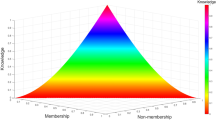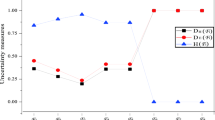Abstract
Uncertainty measurement (UM) can offer new visual angle for data analysis. A fuzzy set-valued information system (FSVIS) which means an information system (IS) where its information values are fuzzy sets. This article investigates UM for a FSVIS. First, a FSVIS is introduced. Then, the distance between two information values of each attribute in a FSVIS is founded. After that, the tolerance relation induced by a given subsystem is acquired by this distance. Moreover, the information structure of this subsystem is brought forward. Additionally, measures of uncertainty for a FSVIS are explored. Eventually, to verify the validity of these measures, statistical effectiveness analysis is carried out. The obtained results will help us understand the intrinsic properties of uncertainty in a FSVIS.


















Similar content being viewed by others
Explore related subjects
Discover the latest articles, news and stories from top researchers in related subjects.References
Bianucci D, Cattaneo G (2009) Information entropy and granulation co-entropy of partitions and coverings: a summary. Trans Rough Sets 10:15–66
Bianucci D, Cattaneo G, Ciucci D (2007) Entropies and co-entropies of coverings with application to incomplete information systems. Fundam Inform 75:77–105
Beaubouef T, Petry FE (2000) Fuzzy rough set techniques for uncertainty processing in a relational database. Int J Intell Syst 15:389–424
Beaubouef T, Petry FE, Arora G (1998) Information-theoretic measures of uncertainty for rough sets and rough relational databases. Inf Sci 109:185–195
Carvalho JG Jr, Costa CT Jr (2019) Non-iterative procedure incorporated into the fuzzy identification on a hybrid method of functional randomization for time series forecasting models. Appl Soft Comput 80:226–242
Cattaneo G, Chiaselotti G, Ciucci D, Gentile T (2016) On the connection of hypergraph theory with formal concept analysis and rough set theory. Inf Sci 330:342–357
Cament LA, Castillo LE, Perez JP, Galdames FJ, Perez CA (2014) Fusion of local normalization and Gabor entropy weighted features for face identification. Pattern Recognit 47(2):568–577
Chen SL, Li JG, Wang XG (2005) Fuzzy sets theory and its application. Chinese Scientific Publishers, Beijing
Chen YM, Xue Y, Ma Y, Xu FF (2017) Measures of uncertainty for neighborhood rough sets. Knowl Based Syst 120:226–235
Duntsch I, Gediga G (1998) Uncertainty measures of rough set prediction. Artif Intell 106:109–137
Delgado A, Romero I (2016) Environmental conflict analysis using an integrated grey clustering and entropy-weight method: a case study of a mining project in Peru. Environ Model Softw 77:108–121
Dai JH, Wei BJ, Zhang XH, Zhang QL (2017) Uncertainty measurement for incomplete interval-valued information systems based on \(\alpha \)-weak similarity. Knowl Based Syst 136:159–171
Gu B, Sheng VS, Wang ZJ, Ho D, Osman S (2015) Incremental learning for \(v\)-support vector regression. Neural Netw 67:140–150
Holčapek M (2016) A graded approach to cardinal theory of finite fuzzy sets, part I: graded equipollence. Fuzzy Sets Syst 298:158–193
Huang YY, Li TR, Luo C, Fujita H, Horng SJ (2017) Dynamic variable precision rough set approach for probabilistic set-valued information systems. Knowl Based Syst 122:131–147
de Hierro AFRL, Roldán C, Herrera F (2018) On a new methodology for ranking fuzzy numbers and its application to real economic data. Fuzzy Sets Syst 353:86–110
Hempelmann CF, Sakoglu U, Gurupur VP, Jampana S (2016) An entropy-based evaluation method for knowledge bases of medical information systems. Expert Syst Appl 46:262–273
Li YL, Chen H, Lv MQ, Li YJ, Li YY (2018) Extracting semantic event information from distributed sensing devices using fuzzy sets. Fuzzy Sets Syst 337:74–92
Li H, Li DY, Zhai YH, Wang S, Zhang J (2016) A novel attribute reduction approach for multi-label data based on rough set theory. Inf Sci 367–368:827–847
Lang GM, Miao DQ, Cai MJ (2017) Three-way decision approaches to conflict analysis using decision-theoretic rough set theory. Inf Sci 406–407:185–207
Liang JY, Qu KS (2002) Information measures of roughness of knowledge and rough sets for information systems. J Syst Sci Syst Eng 10:95–103
Liang JY, Shi ZZ (2004) The information entropy, rough entropy and knowledge granulation in rough set theory. Int J Uncertain Fuzziness Knowl Based Syst 12:37–46
Liang JY, Shi ZZ, Li DY, Wierman MJ (2006) The information entropy, rough entropy and knowledge granulation in incomplete information systems. Int J Gen Syst 35(6):641–654
Liu YJ, Zhang WG, Gupta P (2018) International asset allocation optimization with fuzzy return. Knowl Based Syst 139:189–199
Li ZW, Zhang PF, Ge X, Xie NX, Zhang GQ (2019) Uncertainty measurement for a covering information system. Soft Comput 23:5307–5325
Li ZW, Zhang PF, Ge X, Xie NX, Zhang GQ, Wen CF (2019) Uncertainty measurement for a fuzzy relation information system. IEEE Trans Fuzzy Syst 27:2338–2352
Navara M, Navarová Mária (2017) Principles of inclusion and exclusion for interval-valued fuzzy sets and IF-sets. Fuzzy Sets Syst 324:60–73
Pawlak Z (1991) Rough sets: theoretical aspects of reasoning about data. Kluwer Academic Publishers, Dordrecht
Pawlak Z (1982) Rough sets. Int J Comput Inf Sci 11:341–356
Pawlak Z, Skowron A (2007) Rough sets and Boolean reasoning. Inf Sci 177:41–73
Qian YH, Liang JY, Wu WZ, Dang CY (2011) Information granularity in fuzzy binary GrC model. IEEE Trans Fuzzy Syst 19(2):253–264
Shannon CE (1948) A mathematical theory of communication. Bell Syst Tech J 27:379–423
Shekarian E, Kazemi N, Abdul-Rashid SH, Olugu EU (2017) Fuzzy inventory models: a comprehensive review. App Soft Comput 55:588–621
Tran AD, Arch-int S, Arch-int N (2018) A rough set approach for approximating differential dependencies. Expert Syst Appl 114:488–502
Tan AH, Wu WZ, Tao YZ (2018) A unified framework for characterizing rough sets with evidence theory in various approximation spaces. Inf Sci 454–455:144–160
Wierman MJ (1999) Measuring uncertainty in rough set theory. Int J Gen Syst 28:283–297
Wang ZH, Feng QR, Wang H (2019) The lattice and matroid representations of definable sets in generalized rough sets based on relations. Inf Sci 485:505–520
Xie NX, Liu M, Li ZW, Zhang GQ (2019) New measures of uncertainty for an interval-valued information system. Inf Sci 470:156–174
Xie N, Li Z, Zhang P, Zhang G (2019) Information structures and uncertainty measures in an incomplete probabilistic set-valued information system. IEEE Access 7:27501–27514
Xie SD, Wang YX (2014) Construction of tree network with limited delivery latency in homogeneous wireless sensor networks. Wirel Pers Commun 78(1):231–246
Xu WH, Zhang XY, Zhang WX (2009) Knowledge granulation, knowledge entropy and knowledge uncertainty measure in ordered information systems. Appl Soft Comput 9:1244–1251
Yao YY (2003) Probabilistic approaches to rough sets. Expert Syst 20:287–297
Yao YY, Zhang XY (2017) Class-specific attribute reducts in rough set theory. Inf Sci 418–419:601–618
Zadeh LA (1965) Fuzzy sets. Inf Control 8:338–356
Zhang GQ, Li ZW, Wu WZ, Liu XF, Xie NX (2018) Information structures and uncertainty measures in a fully fuzzy information system. Int J Approx Reason 101:119–149
Acknowledgements
The authors would like to thank the editors and the anonymous reviewers for their valuable comments and suggestions, which have helped immensely in improving the quality of the paper. This work is supported by National Natural Science Foundation of China (11971420), Natural Science Foundation of Guangxi (2018GXNSFDA294003, 2018GXNSFDA281028, 2018GXNSFAA294134), Guangxi Higher Education Institutions of China (Document No. [2018] 35 and [2019] 52), Guangxi Natural Science Foundation (2019AC20052), Key Laboratory of Software Engineering in Guangxi University for Nationalities (2018-18XJSY-03), Research Project of Institute of Big Data in Yulin (YJKY03) and Engineering Project of Undergraduate Teaching Reform of Higher Education in Guangxi (2017JGA179).
Author information
Authors and Affiliations
Corresponding authors
Additional information
Publisher's Note
Springer Nature remains neutral with regard to jurisdictional claims in published maps and institutional affiliations.
Rights and permissions
About this article
Cite this article
Li, Z., Wang, Z., Li, Q. et al. Uncertainty measurement for a fuzzy set-valued information system. Int. J. Mach. Learn. & Cyber. 12, 1769–1787 (2021). https://doi.org/10.1007/s13042-020-01273-6
Received:
Accepted:
Published:
Issue Date:
DOI: https://doi.org/10.1007/s13042-020-01273-6




